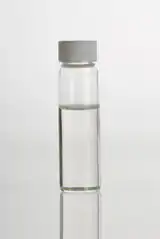Pine oil
Pine oil is an essential oil obtained by the steam distillation of stumps,[2] needles, twigs and cones[3] from a variety of species of pine, particularly Pinus sylvestris. As of 1995, synthetic pine oil was the "biggest single turpentine derivative."[4] Synthetic pine oils accounted for 90% of sales as of 2000.[5]
 Pine (Pinus sylvestris) essential oil in a clear glass vial | |
| Names | |
|---|---|
| Other names
Essential oil of pine Yarmor | |
| Identifiers | |
| 8191505 | |
| ChemSpider |
|
| ECHA InfoCard | 100.219.894 |
| UNII | |
CompTox Dashboard (EPA) |
|
| Properties | |
| Mixture | |
| Appearance | Colorless to pale yellow liquid |
| Density | 0.95 g/cm3 at 25 °C (approximate) |
| Melting point | 5 °C (41 °F; 278 K) |
| Boiling point | 195 °C (383 °F; 468 K) |
| Insoluble | |
| log P | 1.7 |
| Vapor pressure | 4 mmHg |
| Hazards | |
| NFPA 704 (fire diamond) | |
| Flash point | 65 °C (149 °F; 338 K) |
Except where otherwise noted, data are given for materials in their standard state (at 25 °C [77 °F], 100 kPa). | |
| Infobox references | |
In alternative medicine, it is said to be used in aromatherapy, as a scent in bath oils or more commonly as a cleaning product, and as a lubricant in small and expensive clockwork instruments. It may also be used varyingly as a disinfectant, sanitizer, microbicide (or microbistat), virucide or insecticide.[6] It is also used as an effective herbicide where its action is to modify the waxy cuticle of plants, resulting in desiccation.[7]
Pine oil is distinguished from other products from pine, such as turpentine, the low-boiling fraction from the distillation of pine sap, and rosin, the thick tar remaining after turpentine is distilled.
Chemically, pine oil consists mainly of α-terpineol[6] and other cyclic terpene alcohols.[1] It may also contain terpene hydrocarbons, ethers, and esters. The exact composition depends on various factors, such as the variety of pine from which it is produced and the parts of the tree used.
Properties as a disinfectant
Pine oil is a disinfectant that is mildly antiseptic.[8] It is effective against Brevibacterium ammoniagenes, the fungi Candida albicans, Enterobacter aerogenes, Escherichia coli, Gram-negative enteric bacteria, household germs, Gram-negative household germs such as those causing salmonellosis, herpes simplex types 1 and 2, influenza type A, influenza virus type A/Brazil, influenza virus type A2/Japan, intestinal bacteria, Klebsiella pneumoniae, odor-causing bacteria, mold, mildew, Pseudomonas aeruginosa, Salmonella choleraesuis, Salmonella typhi, Salmonella typhosa, Serratia marcescens, Shigella sonnei, Staphylococcus aureus, Streptococcus faecalis, Streptococcus pyogenes, and Trichophyton mentagrophytes.[6]
It will kill the causative agents of typhoid, gastroenteritis (some agents), rabies, cholera, several forms of meningitis, whooping cough, gonorrhea and several types of dysentery.[9] It is not effective against spore related illnesses, such as tetanus or anthrax, or against non-enveloped viruses such as poliovirus, rhinovirus, hepatitis B, or hepatitis C.[9]
Froth flotation
Industrially, pine oil is used as a frother in mineral extraction from ores.[1] For example, in copper extraction pine oil is used to condition copper sulfide ores for froth flotation. Therefore, it is important in the industry for the froth flotation process. It has largely been replaced by synthetic alcohols and polyglycol ethers.
Safety
Pine oil has a relatively low human toxicity level, a low corrosion level and limited persistence; however, it irritates the skin and mucous membranes and has been known to cause breathing problems.[8][10] Large doses may cause central nervous system depression.[1]
See also
- List of cleaning products
- Pine-Sol, cleaning product that originally contained pine oil, though it switched to a different active ingredient in 2013 due to the availability of pine oil
References
- Merck Index, 11th Edition, 7416. p. 1182
- Boyle, Hal (September 12, 1954). "There's Gold in those Pine Stumps". Sarasota Journal. p. 11.
- Macchioni, F.; Cioni, P. L.; Flamini, G.; Morelli, I.; Maccioni, S.; Ansaldi, M. (2003-03-01). "Chemical composition of essential oils from needles, branches and cones of Pinus pinea, P. halepensis, P. pinaster and P. nigra from central ltaly". Flavour and Fragrance Journal. 18 (2): 139–143. doi:10.1002/ffj.1178. ISSN 1099-1026.
- Chapter 1. Production trade and markets. Non-Wood Forest Products 2, Gum naval stores: Turpentine and rosin from pine resin. Rome: Food and Agriculture Organization. 1995. ISBN 978-9251036846.
- Gscheidmeier, Manfred; Fleig, Helmut (June 15, 2000). "Turpentines". Turpentines, 16. Pine Oil. Ullmann's Encyclopedia of Industrial Chemistry. doi:10.1002/14356007.a27_267. ISBN 978-3527306732.
- "Reregistration Decision – Pine oil (case 3113)" (PDF). Environmental Protection Agency. October 2006.
- Coleby-Williams, Jerry (April 9, 2004). "Fact Sheet: Organic Weed Control". Gardening Australia. Retrieved August 28, 2016.
- "Pine Oil". PDRhealth. 2003. Archived from the original on 2007-09-21.
- Detailed Information On Chemical Disinfectants Archived 2011-08-21 at the Wayback Machine University of Arizona Veterinary Diagnostic Laboratory, accessed June 26, 2007.
- "Pine Oil Poisoning". Medlineplus.gov. Retrieved August 28, 2016.
Further reading
- Gscheidmeier, Manfred; Fleig, Helmut (June 15, 2000). "Turpentines". Turpentines, 16. Pine Oil. Ullmann's Encyclopedia of Industrial Chemistry. doi:10.1002/14356007.a27_267. ISBN 978-3527306732.
- "8". TURPENTINE FROM PINE RESIN. Non-Wood Forest Products 1, Flavours and fragrances of plant origin. Rome: Food and Agriculture Organization. 1995. ISBN 978-92-5-103648-8. Archived from the original on January 17, 2011.
